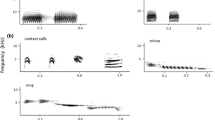Abstract
Alarm calling has been interpreted from the viewpoint of parental investment and nest defence. Calling should increase with an increasing value of the brood to the caller or with increasing vulnerability of the brood. Parental alarm calling might also be viewed from assessment–management with callers using vocalisations to elicit affective responses in others, e.g. in silencing offspring. I examined parental alarm calling in the Cyprus Wheatear (Oenanthe cypriaca) at different developmental stages. The Cyprus Wheatear produces two alarm calls, but one is emitted only during a short period of the year (type II alarm call). The commoner alarm call (type I alarm call), however, is used year-round. Predation was simulated using consistent approach by human observers. The brood cycle was divided into (I) incubation, (II) nestling, (III) early fledging, and (IV) late fledging. Type I calls increased from phases I to III, and decreased afterwards. Type II calls were absent during incubating and occurred during nestling and early fledging stages. As a conclusion, I suggest that the type I alarm call might be used to alert the mate, deter the predator and signal strength of nest defence, while the type II alarm call is addressed to offspring.



Similar content being viewed by others
References
Bernath-Plaisted J, Yasukawa K (2011) Effect of alarm calling by male Red-winged Blackbirds on nestling begging and female provisioning behaviour. J Field Orn 82:394–404
BirdLife International (2004) Birds in the European Union: a status assessment. BirdLife International, Wageningen, The Netherlands
Caro T (2005) Antipredator defenses in birds and mammals. University of Chicago Press, Chicago
Christensen S (1974) Notes on the plumage of the female Cyprus Pied Wheatear Oenanthe pleschanka cypriaca. Ornis Scand 5:47–52
Colombelli-Négrel D, Robertson J, Sulloway FJ, Kleindorfer S (2010) Extended parental care of fledglings: parent birds adjust anti-predator response according to predator type and distance. Behaviour 147:853–870
Curio E (1987) Brood defence in the great tit: the influence of age, number and quality of the young. Ardea 75:33–42
Davies NB, Madden JR, Butchart SHM (2004) Learning fine-tunes a specific response of nestlings to the parental alarm calls of their own species. Proc Royal Soc London B 271:2297–2304
East M (1981) Alarm calling and parental investment in the Robin Erithacus rubecula. Ibis 123:223–230
Fasanella M, Ferández GJ (2009) Alarm calls of the southern house wren Troglodytes musculus: variation with nesting stage and predator model. J Ornithol 150:853–863
Flint P, Stewart P (1992) The birds of Cyprus. British Ornithologist’s Union, Tring
Gill SA, Sealy SG (2003) Test of two functions of alarm calls given by yellow warblers during nest defence. Can J Zool 81:1685–1690
Greig-Smith PW (1980) Parental investment in nest defence by stonechats (Saxicola torquata). Anim Behav 28:604–619
Hollén LJ, Radford AN (2009) The development of alarm call behaviour in mammals and birds. Anim Behav 78:791–800
Johnson M, Aref S, Walters JR (2008) Parent–offspring communication in the western sandpiper. Behav Ecol 19:489–501
Kleindorfer S, Hoi H, Fessl B (1996) Alarm calls and chick reactions in the moustached warbler, Acrocephalus melanopogon. Anim Behav 51:1199–1206
Kudernatsch D, Buchmann M, Fiedler W, Segelbacher G (2010) Extrapair paternity in a German population of the Northern Wheatear (Oenanthe oenanthe). J Ornithol 151:491–498
Madden JR, Kilner RM, Davies NB (2005) Nestling response to adult food and alarm calls: 1. Species-specific responses in two cowbird hosts. Anim Behav 70:619–627
Mallord JW, Orsman CJ, Cristinacce A, Butcher N, Stowe TJ, Charman EC (2012) Mortality of Wood Warbler Phylloscopus sibilatrix nests in Welsh Oakwoods: predation rates and the identification of nest predators using miniature nest cameras. Bird Study 59:286–295
Morton ES, Shalter MD (1977) Vocal response to predators in pair-bonded carolina wrens. Condor 79:222–227
Pavel V, Bures S (2001) Offspring age and nest defence: test of the feedback hypothesis in the meadow pipit. Anim Behav 61:297–303
Platzen D, Magrath RD (2004) Parental alarm calls suppress nestling vocalization. Proc Royal Soc London B 271:1271–1276
Platzen D, Magrath RD (2005) Adaptive significance in response to two types of parental alarm calls in alticial nestlings. Proc Royal Soc London B 272:1101–1106
Randler C, Teichmann C, Pentzold S (2010) Breeding habitat preference and foraging of the Cyprus Wheatear Oenanthe cypriaca and niche partitioning in comparison with migrant Oenanthe species on Cyprus. J Ornithol 151:113–121
Randler C, Förschler MI, Gonzalez J, Aliabadian M, Bairlein F, Wink M (2012) Phylogeography, pre-zygotic isolation and taxonomic status in the endemic Cyprus Wheatear Oenanthe cypriaca. J Ornithol 153:303–312
Randler C (2012) A possible phylogenetically conserved urgency response of great tits (Parus major) towards allopatric mobbing calls. Behav Ecol Sociobiol 66:675–681
Searcy WA, Nowicki S (2005) The evolution of animal communication. Princeton University Press, Princeton
Serra C, Fernández GJ (2011) Reduction of nestlings’ vocalizations in response to parental alarm calls in the Southern House Wren, Troglodytes musculus. J Ornithol 152:331–336
Sluys R, van den Berg M (1982) On the specific status of the Cyprus Pied Wheatear Oenanthe cypriaca. Ornis Scand 13:123–128
Stagg A, Hearl G (1997) A birdwatching guide to Cyprus. Arlequin Press, Essex
Took JME (1971) Breeding records 1971. Cyprus Ornithol Soc (1957) Report 18:40–49
Weatherhead PJ (1979) Do savannah sparrows commit the Concorde fallacy? Behav Ecol Sociobiol 5:373–381
Acknowledgments
The study was carried out during a sabbatical leave. The author is grateful for this opportunity. Two reviewers gave helpful comments that improved the manuscript.
Ethical standards
The experiments comply with the current laws of Cyprus.
Author information
Authors and Affiliations
Corresponding author
Rights and permissions
About this article
Cite this article
Randler, C. Alarm calls of the Cyprus Wheatear Oenanthe cypriaca—one for nest defence, one for parent–offspring communication?. acta ethol 16, 91–96 (2013). https://doi.org/10.1007/s10211-012-0141-1
Received:
Revised:
Accepted:
Published:
Issue Date:
DOI: https://doi.org/10.1007/s10211-012-0141-1






